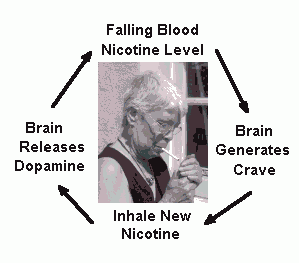Operant conditioning is a form of associative learning that flows from the operation or consequences of behavior. In our case, the behavior is nicotine use, where the consequences of use gradually strengthen use via reinforcement and/or punishment.[1]
Initially, even though hot toxic smoke may have caused our throat and lungs to rebel, our brain sat up and took notice. Within seconds, that first puff of nicotine caused an unearned release of dopamine and fight or flight neurochemicals.
Even though we may not have liked the taste, these positive reinforcing effects were sufficient to cause us to return and inhale nicotine again, and again, and again.
Quicker for some than others, hijacked motivational circuitry was beginning to behave as though nicotine were food. While positive reinforcement alone was sufficient to begin growing dependency's roots, for most, punishment and negative reinforcement were about to begin.
 As our blood's nicotine level gradually declined, most of us eventually started experiencing two additional use consequences: positive punishment (the arrival of wanting and urges), and negative reinforcement (the lesson that use satisfies wanting).
As our blood's nicotine level gradually declined, most of us eventually started experiencing two additional use consequences: positive punishment (the arrival of wanting and urges), and negative reinforcement (the lesson that use satisfies wanting).
While choice was always present, this endless cycle of operant coercion was at first so gradual that few of us were mindful of our loss of use autonomy. For most, the birth of subconscious use governance went unnoticed.
Even if fully aware, we still had to discover a way out, plan our escape, and, at some point, muster the courage to confront and extinguish, what was by then, weeks, months, or years of operant conditioning.
Drug use behavior conditioning reflects unintended expectations training of the subconscious mind. Hundreds or thousands of annual nicotine use repetitions created strong associations between use and satisfaction. Each and every use reinforced using again.[2]
While nicotine's charged "aaah" sensation caused each of us to experience operant conditioning, inside my mind, the more forceful lesson was that use satisfied wanting, urges, and cravings.
Did it really matter how I felt about nicotine's dopamine-adrenaline cocktail? What mattered was silencing the anxieties for it that were building within.
Punishment fear-conditioning pounded home the consequences of ignoring nicotine's two-hour half-life and my brain's level of need (tolerance). It taught me that delaying replenishment can result in feeling anxious, irritable and depressed.
Soon, waiting too long was pounding home the lesson that using early and often helps avoid the onset of withdrawal. Not only were we conditioned to fear withdrawal, inhaling nicotine sooner than needed forced our brains to adjust to tolerating more of it.
Trapped in a perpetual cycle between wanting and relief, is it any wonder that both our subconscious and conscious grew to deeply believe that nicotine use defined who we were, that replenishment was as important as eating, and that life without it would be miserable at best?
The great news is that within 72 hours of ending use that our subconscious has no choice but to begin noticing that we've moved beyond peak withdrawal, which by then is beginning to gradually subside.
While likely still anxious and alert, the most intense part of recovery is over. So long as all nicotine remains on the outside, fears and anxieties associated with avoiding withdrawal's onset will never, ever be encountered again.
While negative reinforcement and punishment operant conditioning are quickly extinguished, positive reinforcement operant conditioning associated with the tease of thousands of old "aaah" replenishment memories will take time and distance to overcome.
While we cannot erase thousands of old "aaah" memories, conscious honesty and dependency mindfulness help us see those memories for what they truly reflect, an accurate record of the times when an actively feeding drug addict briefly satisfied the desire for more.
Recasting them in truthful light can diminish or even end their remaining tease and influence upon us.
But let's not fool ourselves. Each memory remains tied to the same dopamine pathway that created it. Even if we go years without nicotine, the effects of just one powerful puff, dip, chew or vape somehow breathes new life into old "aaah" memories, and at least one aspect of positive operant conditioning.
Whether recognized or not, activated dopamine pathways would immediately re-assign nicotine use the same priority as eating. Whether wanted or not, use would soon have our brain demanding more and us obeying.
The good news is that simply becoming mindful of how operant conditioning controlled us can aid in helping extinguish it and take back control.[3]
Although not always easy, the solution is simple ... no nicotine today!
References:
2. Rose JE, et al, Inter-relationships between conditioned and primary reinforcement in the maintenance of cigarette smoking, British Journal of Addiction, May 1991, Volume 86(5), Pages 605-609.
3. Brewer JA, et al, Craving to Quit: Psychological Models and Neurobiological Mechanisms of Mindfulness Training as Treatment for Addictions, Psychology of Addictive Behaviors, May 28, 2012.
All rights reserved
Published in the USA
